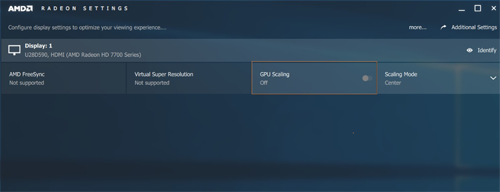GPU scaling is a feature available on most modern graphics cards that allow the GPU to scale the image so that it fits the screen properly, regardless of the resolution. This is especially useful for older games that don’t support higher resolutions, as it can make them look better on modern displays.
Table of Contents
How GPU Scaling Works
GPU scaling works by taking the original image, and stretching or shrinking it to fit the current resolution. This means that if you’re playing a game that only supports a lower resolution, it will be scaled up to fit the higher resolution of your monitor.
GPU scaling is also useful for those who want to run games at a higher resolution than their monitor supports. By enabling GPU scaling, the image can be stretched to fit the screen, allowing for a sharper image. This is especially useful for those who want to run games at 4K resolution on a 1080p monitor.
GPU scaling can also be used to make sure that the image is properly centered on the screen, regardless of the resolution. This can help prevent any distortion or blurriness that can occur when the image is not properly aligned.
How to Enable GPU Scaling
Enabling GPU scaling enables you to conveniently experience more fine-tuned graphics as well as image outputs regardless of the type of resolution.
If you have AMD graphics, you can actually have the GPU scaling option adjusted through AMD catalyst or AMD Radeon graphics. If you want to adjust your GPU scaling, you will need a monitor attached directly to the graphics card adapter through HDMI or DVI.
Games run on lower 5:4 or 4:3 aspect ratios and usually stretch images on a 16:9 screen setting. This tends to produce stretched, `‘poor, and blurred image outputs. The AMD GPU scaling adjusts images to produce much better quality image outputs without actually pixelating the pictures or images.
If you’re using an AMD Radeon Graphics card, just follow the steps provided below to enable or even turn your GPU scaling off:
- On your desktop, in order to get the drop-down menu, you need to right-click and from the menu, choose the “AMD Radeon settings”
- One separate window will appear and in the such window, choose “Display” settings in the menu bar
- Among the numerous options displayed, choose GPU scaling and then enable this or turn this off
- Choose “Scaling Mode” and from the drop-down menu, choose the mode that you prefer
An alternative method is accessing your AMD Catalyst Control Center. If you are wondering, the AMD Radeon Software Crimson or AMD Catalyst pertains to the accompanying software for the AMD Radeon graphics. Just in case you have it already installed in your system, follow these steps in enabling your GPU scaling and turning it off:
- On your desktop, right-click and choose the AMD Catalyst Control Center from the drop-down menu
- Click on the “My Digital Flat Panels option displayed on your right
- From the given options, choose the “Properties” particularly the Digital Flat Panel
- Turn the GPU scaling on and off by means of checking and then unchecking the box
- Choose the scaling mode and click “Apply”

All these steps should be followed in the application of the GPU scaling and the steps on how to enable and disable it. Keep in mind that the GPU scaling feature requires a good digital connection between the graphics adapter and the display unit.
All the information proves useful and helpful to those who are in search of ways how to enable GPU scaling and attempt to obtain high quality and seamless gaming experience.




